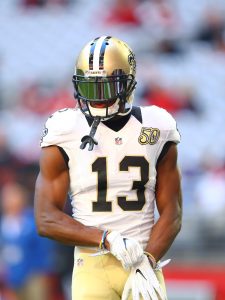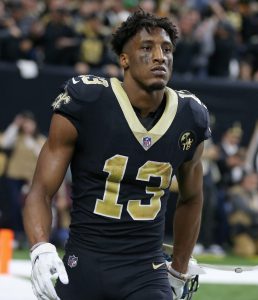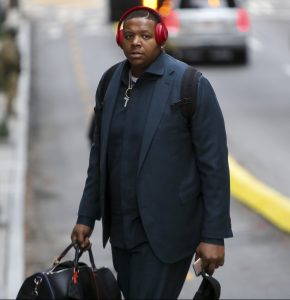Minor NFL Transactions: 10/28/20
Here are Wednesday’s minor moves:
Houston Texans
- Activated from IR: WR Isaiah Coulter
Los Angeles Rams
- Placed on IR: S Terrell Burgess
Minnesota Vikings
- Placed on reserve/COVID-19 list: CB Cameron Dantzler
New England Patriots
- Activated from reserve/COVID-19 list: C James Ferentz
- Placed on IR: LB Brandon Copeland
New Orleans Saints
- Activated from reserve/COVID-19 list: CB Ken Crawley
New York Jets
- Activated from IR: LB Jabari Zuniga
No Trade Offers For Saints’ Michael Thomas?
Depending on who you ask, the Saints might be willing to trade Michael Thomas before the deadline. The wide receiver’s camp is working to find potential deals but, so far, the Saints have yet to receive a concrete offer for the superstar, according to PFT’s Mike Florio.
[RELATED: Saints Deny Thomas Trade Talk]
Thomas’ talent is undeniable, but his contract stands as a major hurdle. A Thomas trade would lead to a $20MM cap charge in 2021, a hit that would be compounded by Drew Brees‘ potential $22.65MM hit. If Thomas gets traded and Brees retires, the Saints would be left with $42.65MM in dead money for two players that are not on the roster.
Thomas inked a massive five-year, $100MM extension in July of 2019 that made him the highest-paid receiver of all time. Lately, he’s been at odds with the team, including a Week 5 benching for an altercation with teammate Chauncey Gardner-Johnson during practice. He’s also been limited due to injuries, including a high ankle sprain and a hamstring issue.
All in all, Thomas has appeared in just one game for New Orleans this year, giving him a stat line of three catches for 17 yards. There’s still reason to believe that Thomas can duplicate last year’s production, though he won’t match the stat line. In 2019, Thomas finished with a single-season-record of 149 receptions to go along 1,725 receiving yards and nine touchdowns.
Saints Shoot Down Thomas Trade, He Might Miss Week 8
- Major waves were made last week when we heard that the Saints could potentially be open to trading Michael Thomas in the wake of his antics that got him suspended for one game for fighting a teammate in practice, but it doesn’t sound like New Orleans’ leadership is seriously considering the idea. Head coach Sean Payton immediately responded to a tweet about the report, mocking the idea that actual ‘insiders’ said any such thing (link via Katherine Terrell of the Athletic). While Thomas probably won’t be dealt he is still hurt, and now Adam Schefter of ESPN.com reports that there’s a good chance Thomas isn’t ready for Week 8 against the Bears due to his hamstring injury. Thomas tweaked his hamstring while working his way back from the high ankle sprain he suffered back in Week 1. With Emmanuel Sanders on the COVID-19 list, the Saints could be without each of their top two wideouts still when they go up against a tough Chicago defense next week.
Minor NFL Transactions: 10/24/20
Here is another spree of Saturday minor moves:
Arizona Cardinals
- Promoted: DL Trevon Coley
Atlanta Falcons
- Promoted: DE Austin Edwards, LB Edmond Robinson
Buffalo Bills
- Placed on IR: LB Tyrel Dodson
Carolina Panthers
- Promoted: G Mike Horton, WR Marken Michel
Chicago Bears
- Moved from IR to reserve/COVID-19 list: CB Michael Joseph
Cincinnati Bengals
- Activated from IR: DT Mike Daniels
- Promoted: CB Winston Rose
- Waived: DT Kahlil McKenzie
Dallas Cowboys
- Activated from IR: OL Cameron Erving
- Promoted: T Jordan Mills, C Adam Redmond
- Placed on IR: T Brandon Knight
Green Bay Packers
- Activated from IR: LB Kamal Martin
- Promoted: S Henry Black, G Ben Braden, RB Dexter Williams, DL Billy Winn
Jacksonville Jaguars
- Activated from IR: RB Devine Ozigbo
- Promoted: S Doug Middleton, TE Eric Saubert
- Placed on reserve/COVID-19 list: RB Chris Thompson
Kansas City Chiefs
- Promoted: OL Danny Isidora, WR Marcus Kemp
- Placed on IR: DL Khalen Saunders
Las Vegas Raiders
- Promoted: CB Dylan Mabin
New England Patriots
- Promoted: LB Tashawn Bower, DT Nick Thurman
New Orleans Saints
- Promoted: WR Austin Carr, OL Will Clapp, WR Juwan Johnson
New York Jets
- Activated from IR: OL Cameron Clark
- Promoted: K/P Sergio Castillo, LB Bryce Hager
Pittsburgh Steelers
- Promoted: FB Trey Edmunds, LB Jayrone Elliott
San Francisco 49ers
- Promoted: S Johnathan Cyprien, S Jared Mayden
Seattle Seahawks
- Promoted: LB Ray-Ray Armstrong
Tennessee Titans
- Activated from IR: S Dane Cruikshank
- Promoted: LB Darren Bates, OL David Quessenberry
Washington Football Team
- Promoted: WR Jeff Badet, WR Tony Brown, DT Devaroe Lawrence
- Placed on IR: OL Saahdiq Charles, WR Antonio Gandy-Golden
Saints “Could Be Willing To Move” WR Michael Thomas
Could an unexpected name be on the move before the November 3rd trade deadline? Mike Florio of ProFootballTalk.com writes that the Saints “could be willing to move” wideout Michael Thomas. Florio notes that the feeling may also be shared by Thomas, who “could be interested in moving.”
 For starters, there are some massive financial hurdles to consider from New Orleans’ side. As Florio details, a Thomas trade would lead to a $20MM cap charge in 2021, and couple that without a potential Drew Brees retirement/$22.65MM charge, the Saints could be eyeing $42.65MM in cap charges for two players who aren’t on their team. Thomas inked a massive five-year, $100MM extension in July of 2019 that made him the highest-paid receiver of all time. The contract was slightly restructured back in March.
For starters, there are some massive financial hurdles to consider from New Orleans’ side. As Florio details, a Thomas trade would lead to a $20MM cap charge in 2021, and couple that without a potential Drew Brees retirement/$22.65MM charge, the Saints could be eyeing $42.65MM in cap charges for two players who aren’t on their team. Thomas inked a massive five-year, $100MM extension in July of 2019 that made him the highest-paid receiver of all time. The contract was slightly restructured back in March.
Of course, those difficulties would be reflected in the hypothetical trade haul the Saints receive; as Florio notes, those financial complications don’t make a trade impossible. After all, the Saints would only accept an offer they couldn’t refuse for the star receiver, and the impending picks in a trade would somewhat make up for the pricey cap charges.
The fact that the Saints would even listen to offers is a bit telling, especially since Thomas appears to be on thin ice in New Orleans. He was benched in Week 5 (and fined a game check) after punching Chauncey Gardner-Johnson during a fight at practice. Thomas has also been limited to only one game after suffering a high ankle sprain, and a new hamstring injury will sideline him for this weekend’s game against the Panthers.
Of course, few suitors would put too much stock into his current production (three receptions, 17 yards). Instead, they’ll look at his incredible 2019 campaign where he finished with a single-season-record 149 receptions to go along 1725 receiving yards and nine touchdowns.
Raiders, Saints Have No New COVID-19 Positives
Good news out of Las Vegas and New Orleans. There were no new positives for the Raiders and Saints during the latest round of testing, reports NFL.com’s Ian Rapoport (via Twitter). This means that both the Raiders-Buccaneers game (which had previously been moved from Sunday night to Sunday afternoon) and the Saints-Panthers game are on track to be played (per Ben Volin of the Boston Globe on Twitter).
 Raiders lineman Trent Brown and cornerback Damon Arnette tested positive for COVID-19 earlier this week. Players who had been in close contact with that duo, including the entire offensive line (Kolton Miller, Denzelle Good, Rodney Hudson and Gabe Jackson), were sent home from the team facility on Wednesday. These high-risk contacts needed to isolate for five days, but considering they were last in contact with Brown or Arnette on Monday, they could all end up playing on Sunday. Safety Johnathan Abram, who was also sent home, had his last contact on Tuesday, so he won’t be allowed to play this weekend.
Raiders lineman Trent Brown and cornerback Damon Arnette tested positive for COVID-19 earlier this week. Players who had been in close contact with that duo, including the entire offensive line (Kolton Miller, Denzelle Good, Rodney Hudson and Gabe Jackson), were sent home from the team facility on Wednesday. These high-risk contacts needed to isolate for five days, but considering they were last in contact with Brown or Arnette on Monday, they could all end up playing on Sunday. Safety Johnathan Abram, who was also sent home, had his last contact on Tuesday, so he won’t be allowed to play this weekend.
We also learned this week that the NFL and NFLPA were investigating the Raiders for COVID-19 compliance. Jarrett Bell of USA Today provided more details on the investigation, noting that the previously reported video “revealed violations of “intensive protocol” measures during practices that included several players not wearing masks or face shields and not adhering to social distancing on the sidelines.” As a result, Bell opines that the Raiders are “seemingly on the verge” of being punished by the league.
In New Orleans, wideout Emmanuel Sanders was placed on the Saints’ reserve/COVID-19 list yesterday. Katherine Terrell of The Athletic tweets that the organization tested about 20 players who had come into contact with Sanders. Cornerback Ken Crawley, who tested negative but was exposed, was also placed on the COVID-19 list.
Minor NFL Transactions: 10/23/20
Here are Friday’s minor moves:
Carolina Panthers
- Activated from reserve/COVID-19 list: K Joey Slye, OL Trent Scott
- Placed on reserve/COVID-19 list: CB Rasul Douglas
New Orleans Saints
- Placed on reserve/COVID-19 list: CB Ken Crawley
- Placed on IR: WR Bennie Fowler
Pittsburgh Steelers
- Promoted: DE Henry Mondeaux
NFL Practice Squad Updates: 10/22/20
Here are Thursday’s practice squad decisions:
Buffalo Bills
- Signed: LB Ahmad Gooden
Carolina Panthers
- Released: RB Michael Warren
Dallas Cowboys
- Signed: DB Saivion Smith
Denver Broncos
- Signed: RB Damarea Crockett
Detroit Lions
- Signed: RB Dalyn Dawkins
New Orleans Saints
- Signed: DE Will Clarke
Minor NFL Transactions: 10/19/20
We’ll keep track of today’s minor moves here:
Arizona Cardinals
- Signed to 53 from practice squad: TE Evan Baylis
Cincinnati Bengals
- Signed: DL Margus Hunt
- Waived: DL Andrew Brown
Dallas Cowboys
- Signed to 53 from practice squad: DT Justin Hamilton
Houston Texans
- Claimed off waivers from Colts: DT Eli Ankou
New Orleans Saints
- Designated to return from IR: RB Ty Montgomery
2020 NFL Cap Space, By Team
As shown by Le’Veon Bell‘s recent deal with the Chiefs, big name free agents can come available at any point throughout the season. His contract wasn’t particularly pricey, but teams like to keep cash on hand during the year, especially when mulling potential trades before the deadline. Excess cap room can also be rolled over from year-to-year and give clubs the opportunity to lock up their most valuable players with extensions.
Here are the most recent figures for each team, via Over The Cap:
- Cleveland Browns – $33.1MM
- New York Jets – $27.9MM
- Dallas Cowboys — $23.9MM
- Washington Football Team – $23.6MM
- Jacksonville Jaguars– $22.9MM
- New England Patriots – $22.9MM
- Denver Broncos – $19.7MM
- Detroit Lions – $17MM
- Philadelphia Eagles– $18MM
- Miami Dolphins – $15.8MM
- Indianapolis Colts – $10.4MM
- Pittsburgh Steelers – $9.6MM
- Cincinnati Bengals– $9MM
- Baltimore Ravens – $9MM
- Arizona Cardinals– $8.9MM
- Chicago Bears – $8.4MM
- Tennessee Titans – $8.3MM
- Houston Texans – $8.1MM
- Los Angeles Chargers — $8MM
- New Orleans Saints – $8MM
- Green Bay Packers – $7.7MM
- New York Giants – $7.2MM
- Los Angeles Rams – $7MM
- Las Vegas Raiders – $6.3MM
- Carolina Panthers – $6.2MM
- Kansas City Chiefs – $5.8MM
- Buffalo Bills – $5MM
- San Francisco 49ers – $4MM
- Seattle Seahawks – $4MM
- Atlanta Falcons – $2MM
- Tampa Bay Buccaneers – $1.4MM
- Minnesota Vikings – $158K
